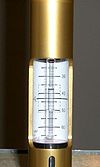Inserting NMR Sample: Difference between revisions
No edit summary |
No edit summary |
||
| Line 3: | Line 3: | ||
== Adjusting sample depth with a sample gauge == | == Adjusting sample depth with a sample gauge == | ||
[[Image:Gauge sch.jpg|right|100px | [[Image:Gauge sch.jpg|right|100px]]First, the NMR tube has to be inserted into a spinner turbine. For best results, NMR tubes should be positioned in the spinner turbine so that the sample volume will be centered in the NMR probe. This can be done with the help of a sample gauge, which usually has a center line and rectangular markings to indicate the probe geometry.<br> | ||
A sample gauge also has an adjustable bottom, which can be adjusted to allow quick posistioning of a series of identical samples. Setting a sample tube too low may cause it to break, as well as contaminate and damage the probe! | A sample gauge also has an adjustable bottom, which can be adjusted to allow quick posistioning of a series of identical samples. Setting a sample tube too low may cause it to break, as well as contaminate and damage the probe! | ||
It is also important to make sure that the tube sits firmly in the spinner. If your sample slides too easily inside a spinner turbine, it may indicate that its rubber o-rings need replacement. | It is also important to make sure that the tube sits firmly in the spinner. If your sample slides too easily inside a spinner turbine, it may indicate that its rubber o-rings need replacement. | ||
== Inserting and ejecting == | == Inserting and ejecting == | ||
To access the '''Insert''' and '''Eject''' buttons do the following:<br> | |||
*VNMR - click on the '''Acqi''' button or type <tt>acqi</tt><br> | |||
*VNMRJ - click on the '''Setup''' tab | |||
You can also type <tt>insert</tt> or <tt>i</tt> and <tt>eject</tt> or <tt>e</tt> at the command prompt in VNMR or VNMRJ. | |||
Sample change procedure | |||
#Eject the current sample first. Even if there is no sample in the magnet you need to use eject to create airflow. | |||
#Remove the ejected sample.<br> | |||
#Eject the current sample first. Even if there is no sample in the magnet you need to use eject to create | |||
#Remove the ejected sample. | |||
#Verify that you have the airflow to support your sample. Carefully insert the sample in the bore. | #Verify that you have the airflow to support your sample. Carefully insert the sample in the bore. | ||
# | #Click on Insert to lower your sample.<br> | ||
Avoid leaving the spectrometer with an open bore for long periods of time, as this increases the risk contaminating the bore with forieign particles. If you need to remove a sample and have nothing else to measure, either insert a standard NMR sample or cover the bore with a dedicated plug. | |||
<br> | <br> | ||
| Line 41: | Line 31: | ||
== External links == | == External links == | ||
[http://www.varianinc.com/image/vimage/docs/products/nmr/apps/pubs/manuals/0199931300b.pdf www.varianinc.com/image/vimage/docs/products/nmr/apps/pubs/manuals/0199931300b.pdf] | [http://www.varianinc.com/image/vimage/docs/products/nmr/apps/pubs/manuals/0199931300b.pdf www.varianinc.com/image/vimage/docs/products/nmr/apps/pubs/manuals/0199931300b.pdf] | ||
Revision as of 22:35, 3 November 2009
Adjusting sample depth with a sample gauge
First, the NMR tube has to be inserted into a spinner turbine. For best results, NMR tubes should be positioned in the spinner turbine so that the sample volume will be centered in the NMR probe. This can be done with the help of a sample gauge, which usually has a center line and rectangular markings to indicate the probe geometry.
A sample gauge also has an adjustable bottom, which can be adjusted to allow quick posistioning of a series of identical samples. Setting a sample tube too low may cause it to break, as well as contaminate and damage the probe!
It is also important to make sure that the tube sits firmly in the spinner. If your sample slides too easily inside a spinner turbine, it may indicate that its rubber o-rings need replacement.
Inserting and ejecting
To access the Insert and Eject buttons do the following:
- VNMR - click on the Acqi button or type acqi
- VNMRJ - click on the Setup tab
You can also type insert or i and eject or e at the command prompt in VNMR or VNMRJ.
Sample change procedure
- Eject the current sample first. Even if there is no sample in the magnet you need to use eject to create airflow.
- Remove the ejected sample.
- Verify that you have the airflow to support your sample. Carefully insert the sample in the bore.
- Click on Insert to lower your sample.
Avoid leaving the spectrometer with an open bore for long periods of time, as this increases the risk contaminating the bore with forieign particles. If you need to remove a sample and have nothing else to measure, either insert a standard NMR sample or cover the bore with a dedicated plug.
External links
www.varianinc.com/image/vimage/docs/products/nmr/apps/pubs/manuals/0199931300b.pdf
